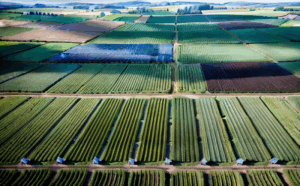The recent decision by Perth and Kinross councillors to reject a substantial solar energy development near Coupar Angus has set the stage for a full public inquiry, bringing the contentious issue of renewable energy expansion on prime agricultural land into sharper focus for the local community. This proposed 110-megawatt (MW) facility, earmarked to sprawl across an expansive 105 hectares – an area equivalent to about 146 football pitches – between the rural settlements of Burrelton and Coupar Angus, includes both solar photovoltaic panels and significant battery storage infrastructure.
The sheer scale of the project, initiated by Sirius EcoDev (Stirling) Ltd, means that its ultimate fate rests not with the local authority, but with the Scottish Government’s Energy Consents Unit. However, Perth and Kinross Council, as a statutory consultee in such large-scale planning matters, holds a crucial advisory position. It was their recent planning and placemaking committee meeting that delivered a surprising blow to the developers, as councillors voted against the project, diverging from the recommendations put forward by the council’s own planning officers.
This council vote, which directly contradicts the professional advice received, has now necessitated a public local inquiry. This formal process will provide a platform for all interested parties – including developers, council representatives, and crucially, local residents – to present their arguments and concerns in detail before an independent reporter. The outcome of this inquiry will then inform the Scottish Ministers’ final decision. Local Concerns on Prime Agricultural Land
The controversy surrounding this particular solar farm is not isolated but rather indicative of a broader and growing apprehension within Perth and Kinross concerning the proliferation of large-scale renewable energy installations, particularly around the Coupar Angus vicinity. The fertile lands of Perthshire, renowned for their agricultural productivity, are increasingly becoming targets for various wind, solar, and battery storage schemes, raising questions about land use, visual impact, and the balance between national energy objectives and local environmental and community well-being.
A pertinent recent example is the Markethill Solar Farm, another substantial development spanning 91 hectares in the same area. This project was firmly rejected by local councillors in December 2023, following a significant outcry that saw 173 objections lodged by concerned citizens. Despite the local council’s refusal, the developers subsequently appealed the decision, leading to the case being ‘called in’ by Scottish Ministers, who are still deliberating on its approval or rejection. The uncertainty surrounding Markethill adds another layer of complexity to the planning landscape in the region.
Councillor Bob Brawn, who represents the Blairgowrie and Glens ward for the Conservative party, was instrumental in spearheading the council’s objection to the Stirling Battery and Solar Energy Park application. Speaking passionately about the decision, Councillor Brawn articulated the rationale behind his stance, stating, “I think a public local inquiry is deserved in this instance in this area. It would be a good thing for everyone whatever the outcome is. People will get their chance to speak.” His words underscore the belief that a transparent and thorough examination of the proposal’s merits and drawbacks, particularly its impact on the rural character and agricultural viability of Perthshire, is essential. A Precedent-Setting Inquiry Ahead
In contrast to the councillors’ vote, Kristian Smith, the council’s building standards and development management service manager, had previously advised that planning policy generally permits energy developments of this type even on prime agricultural land. He further indicated that his team had meticulously assessed the cumulative impact of this proposal alongside other existing and planned green energy schemes across the region and had concluded that, from an officer’s perspective, such an impact was deemed “acceptable.” This highlights the tension between local democratic will and professional planning assessments, often guided by broader national energy strategies.
The final vote within the planning and placemaking committee reflected this division. A coalition of seven councillors – comprising four Conservatives, a Liberal Democrat, an Independent member, and even the local Strathmore ward’s Scottish National Party councillor, Grant Stewart – collectively voted to formally object to the development. This cross-party consensus on objection signals a strong local resistance. Conversely, the remaining four Scottish National Party councillors present voted against formally objecting, aligning with the officers’ recommendation.
The upcoming public inquiry therefore represents a critical juncture for the Coupar Angus area and indeed for Perth and Kinross as a whole. It will not only determine the fate of this specific 110MW solar and battery storage facility but may also set a precedent for how future large-scale renewable energy projects are evaluated and integrated into the cherished landscapes of Perthshire. Residents, farmers, environmentalists, and policymakers will be keenly observing the proceedings, as the inquiry seeks to navigate the complex interplay between the urgent need for green energy and the equally vital imperative to preserve Scotland’s valuable agricultural land and rural heritage. The inquiry process is designed to ensure that all voices are heard, providing a comprehensive assessment before a final ministerial decision is rendered, one that will undoubtedly shape the future of this corner of Tayside.
The sheer scale of the project, initiated by Sirius EcoDev (Stirling) Ltd, means that its ultimate fate rests not with the local authority, but with the Scottish Government’s Energy Consents Unit. However, Perth and Kinross Council, as a statutory consultee in such large-scale planning matters, holds a crucial advisory position. It was their recent planning and placemaking committee meeting that delivered a surprising blow to the developers, as councillors voted against the project, diverging from the recommendations put forward by the council’s own planning officers.
This council vote, which directly contradicts the professional advice received, has now necessitated a public local inquiry. This formal process will provide a platform for all interested parties – including developers, council representatives, and crucially, local residents – to present their arguments and concerns in detail before an independent reporter. The outcome of this inquiry will then inform the Scottish Ministers’ final decision. Local Concerns on Prime Agricultural Land
The controversy surrounding this particular solar farm is not isolated but rather indicative of a broader and growing apprehension within Perth and Kinross concerning the proliferation of large-scale renewable energy installations, particularly around the Coupar Angus vicinity. The fertile lands of Perthshire, renowned for their agricultural productivity, are increasingly becoming targets for various wind, solar, and battery storage schemes, raising questions about land use, visual impact, and the balance between national energy objectives and local environmental and community well-being.
A pertinent recent example is the Markethill Solar Farm, another substantial development spanning 91 hectares in the same area. This project was firmly rejected by local councillors in December 2023, following a significant outcry that saw 173 objections lodged by concerned citizens. Despite the local council’s refusal, the developers subsequently appealed the decision, leading to the case being ‘called in’ by Scottish Ministers, who are still deliberating on its approval or rejection. The uncertainty surrounding Markethill adds another layer of complexity to the planning landscape in the region.
Councillor Bob Brawn, who represents the Blairgowrie and Glens ward for the Conservative party, was instrumental in spearheading the council’s objection to the Stirling Battery and Solar Energy Park application. Speaking passionately about the decision, Councillor Brawn articulated the rationale behind his stance, stating, “I think a public local inquiry is deserved in this instance in this area. It would be a good thing for everyone whatever the outcome is. People will get their chance to speak.” His words underscore the belief that a transparent and thorough examination of the proposal’s merits and drawbacks, particularly its impact on the rural character and agricultural viability of Perthshire, is essential. A Precedent-Setting Inquiry Ahead
In contrast to the councillors’ vote, Kristian Smith, the council’s building standards and development management service manager, had previously advised that planning policy generally permits energy developments of this type even on prime agricultural land. He further indicated that his team had meticulously assessed the cumulative impact of this proposal alongside other existing and planned green energy schemes across the region and had concluded that, from an officer’s perspective, such an impact was deemed “acceptable.” This highlights the tension between local democratic will and professional planning assessments, often guided by broader national energy strategies.
The final vote within the planning and placemaking committee reflected this division. A coalition of seven councillors – comprising four Conservatives, a Liberal Democrat, an Independent member, and even the local Strathmore ward’s Scottish National Party councillor, Grant Stewart – collectively voted to formally object to the development. This cross-party consensus on objection signals a strong local resistance. Conversely, the remaining four Scottish National Party councillors present voted against formally objecting, aligning with the officers’ recommendation.
The upcoming public inquiry therefore represents a critical juncture for the Coupar Angus area and indeed for Perth and Kinross as a whole. It will not only determine the fate of this specific 110MW solar and battery storage facility but may also set a precedent for how future large-scale renewable energy projects are evaluated and integrated into the cherished landscapes of Perthshire. Residents, farmers, environmentalists, and policymakers will be keenly observing the proceedings, as the inquiry seeks to navigate the complex interplay between the urgent need for green energy and the equally vital imperative to preserve Scotland’s valuable agricultural land and rural heritage. The inquiry process is designed to ensure that all voices are heard, providing a comprehensive assessment before a final ministerial decision is rendered, one that will undoubtedly shape the future of this corner of Tayside.


